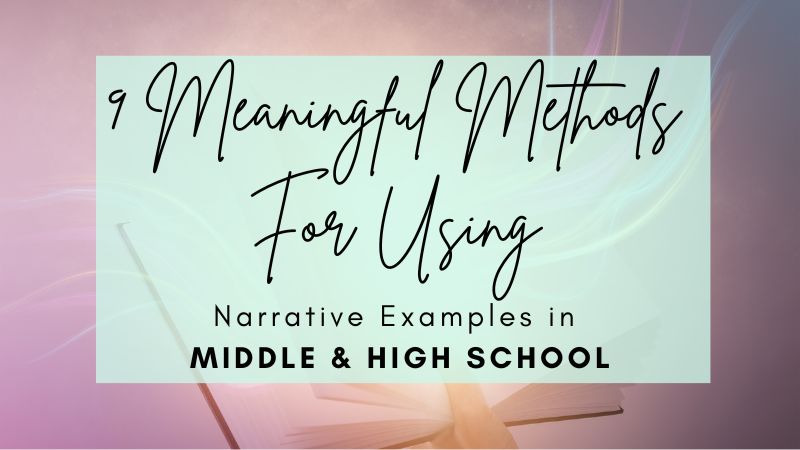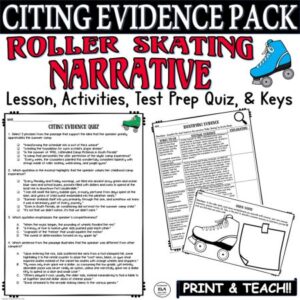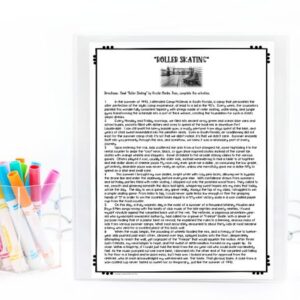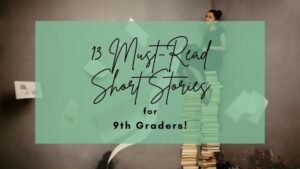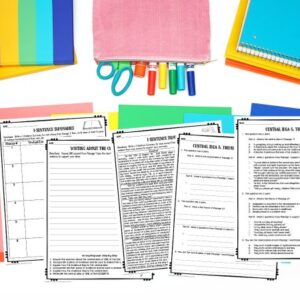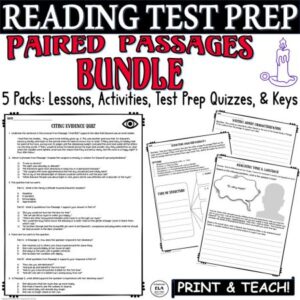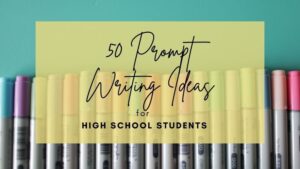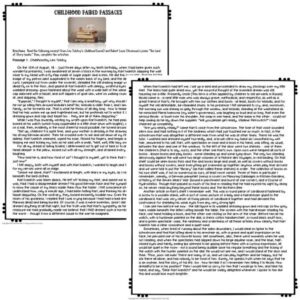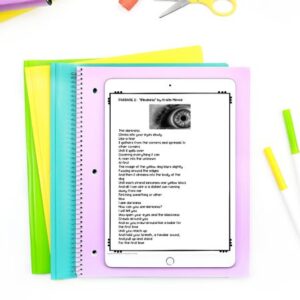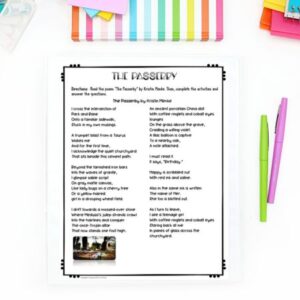In the past, I have not been a huge fan of incorporating personal narrative examples in my curriculum. Narratives seemed too simplistic, a type of writing meant for the elementary classroom. Besides, students should be good at telling stories by the time they reach middle and high school, right?
I reflect on this attitude concerning narrative examples now with major regret. I mean, there are so many uses for stories in our culture, and narratives are vital to how we relate to one another.
We see narrative examples through videos, reels, short films, documentaries, sermons, diaries, letters, and websites! Stories enable society to connect. I am a true believer in using narratives more fully in how and what I teach!
Keep reading below for 9 Meaningful Methods for Using Narrative Examples!
Need help with Test Prep? Check out this FREE Pack of 3 Test Prep Activities to help students achieve success on standardized tests!

9 Meaningful Methods for Using Narrative Examples
1. Incorporate within a Thematic Unit
In college, I remember learning about and creating thematic units; however, they are WAY undervalued in the real world of education. Many texts are taught in isolation because of a lack of planning time, access to literary resources, and a working copier. So often, the district-mandated curriculum is overarching instead of individualized for each classroom.
This creates an unfortunate situation, so one of the things I like to do is add a narrative story or two within a thematic unit.
For example, if you are teaching about “Coming of Age,” you could incorporate the following narratives:
- “Roller Skating” by Kristin Menke
- “Thank You, M’am” by Langston Hughes
- “Hardware” by Kristin Menke
- “The Scarlet Ibis” by James Hurst
- an excerpt from Leo Tolstoy’s Childhood (novel)
If you have never read, “Roller Skating,” check out this first paragraph:
1 In the summer of 1992, I attended Camp McGinnis in South Florida, a camp that personifies the utter perfection of the idyllic camp experience, at least to a kid in the 90’s. Every week, the counselors painted this wonderfully consistent tapestry with strings made of roller skating, waterskiing, and jungle gyms transforming the schedule into a sort of thick weave, creating the foundation for such a child’s utopic dream.
“Survival” is another thematic unit topic taught all over the country. If you want to include more narrative examples, you might consider the following stories from Jack London:
There are so many narrative examples available that can easily be incorporated; they don’t have to take weeks to teach either!
If you need short story ideas for high school, click below!
2. Build Reading Comprehension Skills
The main reason certain picture books for little kids are so popular is because they incorporate stories, and many really good ones are narrative examples! They tell stories, whether fiction or nonfiction, that kids can relate to in some real, tangible way.
We should, therefore, include narrative examples within our teaching to build reading comprehension. Research has shown that students struggle with reading informational texts, and while that may be true, one of the BEST methods for growing comprehension skills is to read fiction and/or stories!
Click the image below for reading comprehension resources that include a personal narrative!
There are so many standards you could focus on:
- Character Traits
- Character Development
- Vocabulary
- Literary Devices
- Context Clues
- Summarizing
- Theme
- Central Idea
- Making Inferences
- Textual Evidence
- Point of View
- Author’s Purpose
- Dialogue
- Structure
- Plot
The sky is the limit!
You could practice with these standards in pre-reading, during-reading, and after-reading activities!
Need 2 narratives for reading test prep? Click below!
PRE-READING ACTIVITIES:
- Journal Entry- Let students write in response to a topic relating to the topic, theme, and/or characters in the story.
- Define and Explain the Standard- Sometimes, students don’t understand the concept even in their secondary years.
- Research Vocabulary- If students can research 5-10 words from a text ahead of time, they will feel more comfortable with the text before reading it.
DURING-READING ACTIVITIES
- Track Traits- As dynamic characters change throughout the story, students can locate evidence to show how the characters develop.
- Diagram the Plot- Every good narrative has a plot; students can identify each plot element based on evidence from the story.
- Summarizing- Instead of summarizing the entire story, students can create 1-sentence summaries for various paragraphs, excerpts, or chunks!
AFTER-READING ACTIVITIES
- Create Questions- Students can use question stems for various standards to write their own reading comprehension questions.
- Take a Short Quiz- I actually enjoy giving quick test prep quizzes for narratives or short stories throughout the year rather than right before testing season.
- Identify the Theme- Teaching about theme is tough; if you need help with this process, click HERE for a fun activity to introduce the concept of theme!
3. Practice Perspective Writing
We live in a world where it can be difficult to step into someone’s shoes, and while we cannot assume we can understand everything about everyone and every situation, we can always ask and attempt to emphathize.
Here are several activities to help students understand the concept of perspective:
- Students could rewrite the story from an initial first-person point of view into a second-person or third-person point of view.
- Students could choose another person in the story and write from his/her point of view.
- Students could choose an object or animal and write a narrative from its perspective.
- Students could choose another format for the narrative and change up their perspective creatively.
- Students could choose certain sentences and rewrite them from varying points of view.
4. Integrate with Other Subject Areas
Narratives are so powerful and impactful because they can tell us stories about really anything. Narratives exist in political speeches, scientific documentaries, religious texts, historical books, cultural myths, music lyrics, and even math problems! Many word problems contain a narrative of some sort!
They don’t have to be long, drawn-out narratives. The narrative might be a single sentence, short paragraph, or one-page poem!
5. Teach Literary Techniques
Before students can fully and effectively use literary techniques in their personal writing, they may need help defining, identifying, and analyzing them within narrative examples!
LITERARY TECHNIQUES:
- Plot Elements- Exposition, Rising Action, Climax, Falling Action, and Resolution are 5 main plot elements.
- Dialogue- The conversation between people, a speaker and him/herself, or a narrator and something else is dialogue.
- Perspective- Point of view transcends first, second, or third person. Knowing details about the narrator and/or protagonist is vital.
- Imagery- A description that appeals to the five senses is imagery. It livens up the story and engages the reader.
- Devices- You can teach so many devices like metaphor, simile, idiom, onomatopoeia, oxymoron, hyperbole, understatement, etc. while reading narrative examples.
- Setting- Setting is simply the description of the time and the place of the story.
6. Research Narrative Writers
I enjoy history and exploring various cultures; however, many students don’t want to dig more deeply when it comes to learning about writing and literature.
Why not have students research an important or not-so-important person from history who wrote in a narrative form?
- Anne Bradstreet
- Sojourner Truth
- Olaudah Equiano
- Frederick Douglass
- Phillis Wheatley
- Thomas Jefferson
- George Washington
- Walt Whitman
- Betty White
- Elon Musk
- Michael J. Fox
- Corrie Ten Boom
- Anne Frank
- Viola Davis
- Michelle Obama
- ANYONE who has written a narrative in whatever format!
They can find information about the person’s early life, major events, important narrative excerpts, etc. Then, they could present the information to the class and read one of the person’s narrative examples!
7. Examine Media Narratives
People tell their stories all over media; you just have to listen. So what makes a narrative compelling, interesting, important, or memorable?
One fun lesson might include teaching various short narratives from social media, online videos, personal/business websites, news channels, music, movies, etc. There are so many stories nowadays interwoven into our societal psyche. They link us through a laugh, smile, tear, frustration, anger, or really what it means to be human!
After students have viewed these narrative examples and found their own to examine, you could have a time of reflection and discussion.

The S.P.A.U.T.S. method might help!
S-Speaker
P-Purpose
A-Audience
U-Universal Ideas
T-Tone
S-Strategies
An ending critique of the narrative would round out the lesson well!
8. Create Digital Narratives
After you have read, examined, analyzed, and even critiqued other narrative examples, an engaging project would be to create a digital narrative. I don’t know about you, but I love scrolling! Yes, it can easily become an obsession, but when you have a newborn sleeping in your arms, anything to keep your mind occupied and/or entertained is welcomed.
Why not have students create digital narratives after reading narrative examples from various genres?
Creation Process:
- Offer formats for student choice.
- Provide various topics.
- Encourage students to focus on a specific purpose and audience of the narrative.
- Allow for a class period or two to plan out the narrative within a certain time frame.
- Arrange time for students to record and/or put together the narrative.
- Give time to present the digital narrative.
9. Explore Other Forms of Written Narratives
Narrative examples don’t have to come in a short story format of paragraphs and several pages of writing. We have so many options nowadays.
TYPES OF NARRATIVE FORMS:
- Poetry
- Songs
- About Me Page
- Skits
- Ads
- Transcripts
- Letters
Why should you include more narrative examples in your teaching?
- They are fun!
- They are usually short!
- They relay the human experience!
- They many times have an important message!
- They include creative language throughout!
What do you have to lose?
Need more fun ideas that incorporate narrative examples? Check out my store Kristin Menke-Integrated ELA Test Prep!

